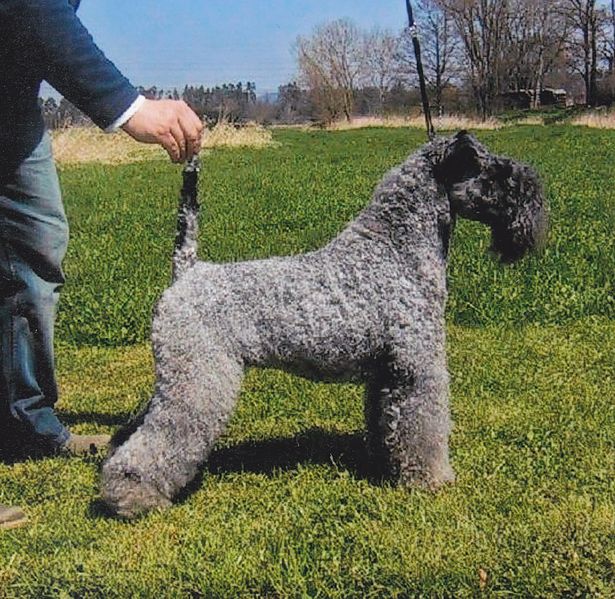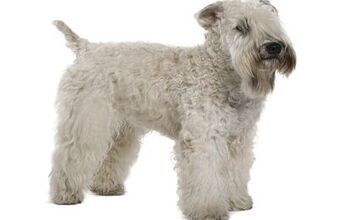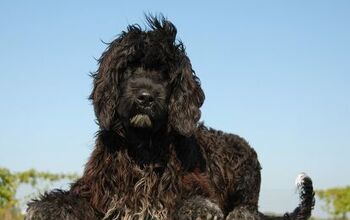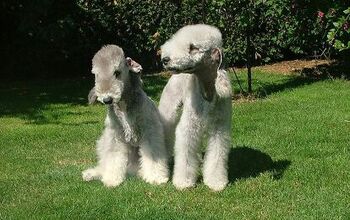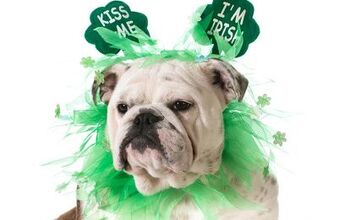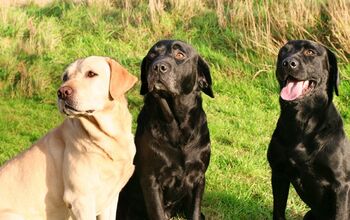Kerry Blue Terrier


About Kerry Blue Terrier
There’s no reason to feel blue when you’ve got a Kerry Blue Terrier! You can say this breed comes with it all – it’s an all-around working, watch, utility and companion dog, all rolled into one amazing pooch. Known for its intelligence, versatility and loyalty to its owners, the Kerry Blue Terrier (also referred to as Kerries or the Blue) loves to spend his time hunting, chasing and exploring.
A wonderful dog for family and active or outdoorsy people, the Kerry Blue Terrier loves to keep active. He boasts a typical terrier personality, so he’ll need daily exercise and firm and patient training. This may not be a well-known breed in North America, but the Blue enjoys a loyal following, thanks to his strong work ethic and loyal companionship. Please read on to learn more about this breed.
Known for its intelligence, versatility and loyalty to its owners, the Kerry Blue Terrier loves to spend his time hunting, chasing and exploring.
The Kerry Blue Terrier can trace its roots to back to the mountainous regions of County Kerry, near Lake Killarney, Ireland, sometime in the late 1700s or early 1800s. This dog was bred for working purposes – it would tend livestock, hunt small game, kill vermin, and watch over its owners and property. In time, he also became a beloved companion – no wonder he’s the National Dog of Ireland.
It’s not known for sure, but many experts believe that the Kerry Blue Terrier’s linage can be traced back to Irish, Welsh, Bedlington and Soft-Coated Wheaten Terriers.
This is an active breed, so you’ll have to ensure that your Kerry Blue Terrier gets enough fuel. Depending on brand, you should feed your Blue 1.5 to 2 cups of high-quality dry food a day. Whatever food you do go with, make sure that it contains enough calcium and proteins.
The Kerry Blue Terrier is intelligent, but being a typical terrier, he’s also quite stubborn.
The Kerry Blue Terrier is intelligent, but being a typical terrier, he’s also quite stubborn. Being such an observant dog, the Blue will watch to see who is in charge and how they can turn any situation to their advantage. If he senses that you’re not in charge at all times, your Kerry Blue Terrier will gladly take charge. Be consistent and confident when training your Blue and never let him get the upper hand. You’ll find that you’ll make much more progress by using positive training techniques. Come to training prepared with plenty of treats and keep these sessions interesting – your Kerry will lose focus if he gets bored.
After he masters basic obedience training, your Kerry Blue Terrier is ready to move onto advanced obedience, agility and earthdog training. Because this is an intelligent breed, you need to keep his mind stimulated, otherwise he’ll engage in destructive behaviors.
The Kerry Blue Terrier’s weight ranges from 33 to 40 pounds.
This energetic dog loves to play and be active. He’ll want to be included in all of your family activities. You can take your Blue on hikes, jogs and walks, but you’ll find that he’s happiest playing a game of fetch in the backyard. He likes to play with children, but he should be watched closely when playing with younger children, due to his fondness for rough housing.
The Kerry Blue Terrier is wary of strangers, so this breed makes an excellent watchdog. They will protect their family and home, but aren’t considered an aggressive dog (unless provoked). If you have other dogs in the household, you’ll need to introduce your Blue into the pack as early as possible. Socialization and Puppy Kindergarten class can help familiarize your dog to new people, animals and experiences. Smaller animals should not be kept in the same house as a Kerry Blue Terrier due to their strong chasing and hunting instinct.
There are some breed health concerns, but they may not affect your dog. These include ear infections, epidermal or sebaceous gland cysts, skin cysts, dry eye, cataracts, entropion, footpad keratoses, hip dysplasia, hypothyroidism, missing teeth, patellar luxation and Factor Xl Deficiency (Plasma Thromboplastin Antecedent Deficiency).
The Kerry Blue Terrier has an average lifespan of 12 to 15 years.
Can you keep up with the Kerry Blue Terrier? He needs lots of physical and mental stimulation to keep him in tip-top shape. Just when you think that they’ve had enough, they will hit their second wind. The Blue does best in a house with a yard or in a rural area. Be prepared to give your dog about an hour of vigorous exercise every day – this can include walks, jogs, hikes or playing in the yard. To keep both his mind and body active, consider agility and earthdog training.
This energetic dog loves to play and be active.
The American Kennel Association says this about the breed: “Intelligent and game, the Kerry Blue Terrier is truly an all-purpose dog. Originally bred to hunt and retrieve, Kerries can be found today in the show, obedience, agility, herding and earthdog rings.” The AKC first recognized this breed in 1922.
The Kerry Blue Terrier sports a soft, dense, and wavy coat. Coat colors are blue or gray, and range in shades from dark to light. As puppies, coats are black, but will lighten as they get older. Black and white markings may be present.
The Blue is a light shedder, but you’ll still need to brush him daily in order to prevent tangles and mats.
Socialization is especially important with this breed. The Kerry Blue Terrier is wary of strangers and other animals, so you need to introduce your Blue to as many people and animals as you can – the sooner, the better.

Amy Tokic, Editor of PetGuide.com, is a passionate animal lover and proud pet parent of Oscar, a Shih Tzu/Chihuahua cross, and Zed, a Japanese Chin. Her love of animals began in kindergarten, when she brought her stuffed dog Snoopy into class with her every day. Now, she writes about her adventures in pet ownership and tirelessly researches products, news and health related issues she can share with other animal enthusiasts. In her free time, Amy loves perusing used book and record stores, obsessing over the latest pet products available and chasing squirrels with wild abandon (a habit attributed to spending too much time with her pooches).
More by Amy Tokic




